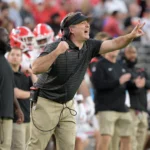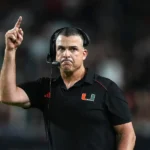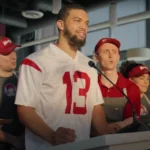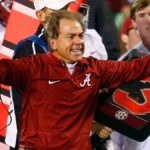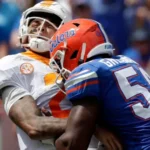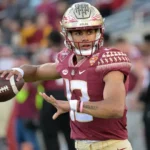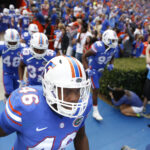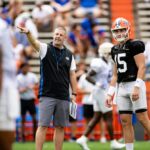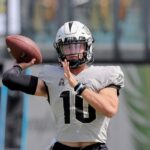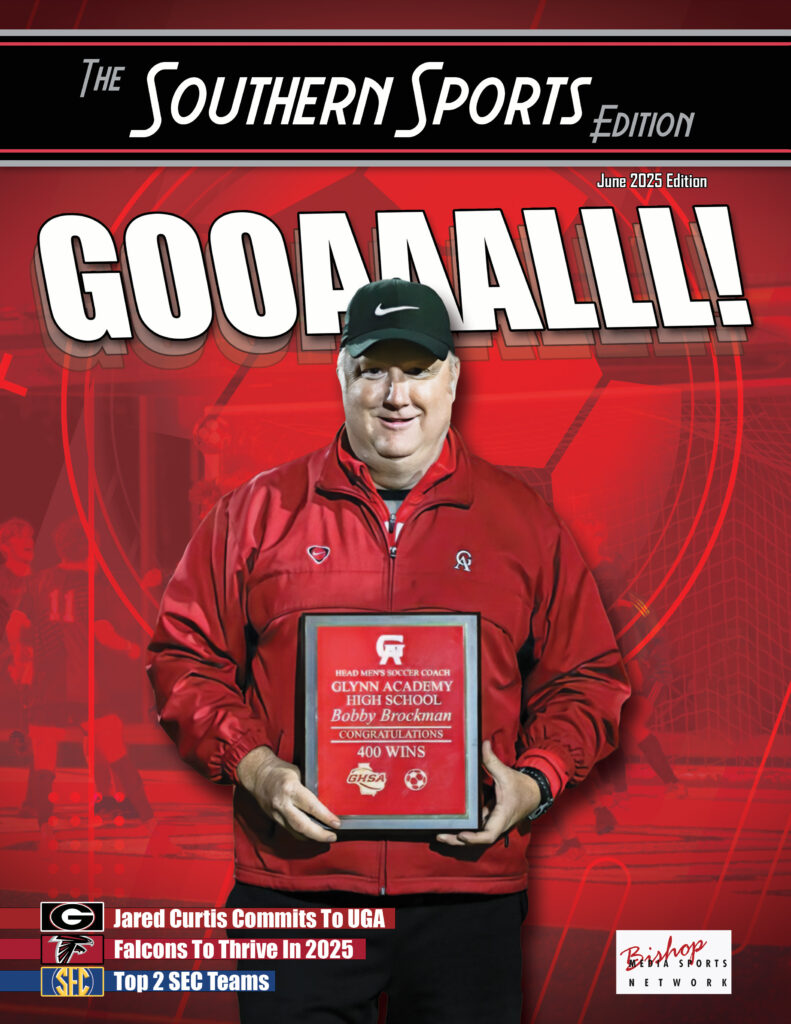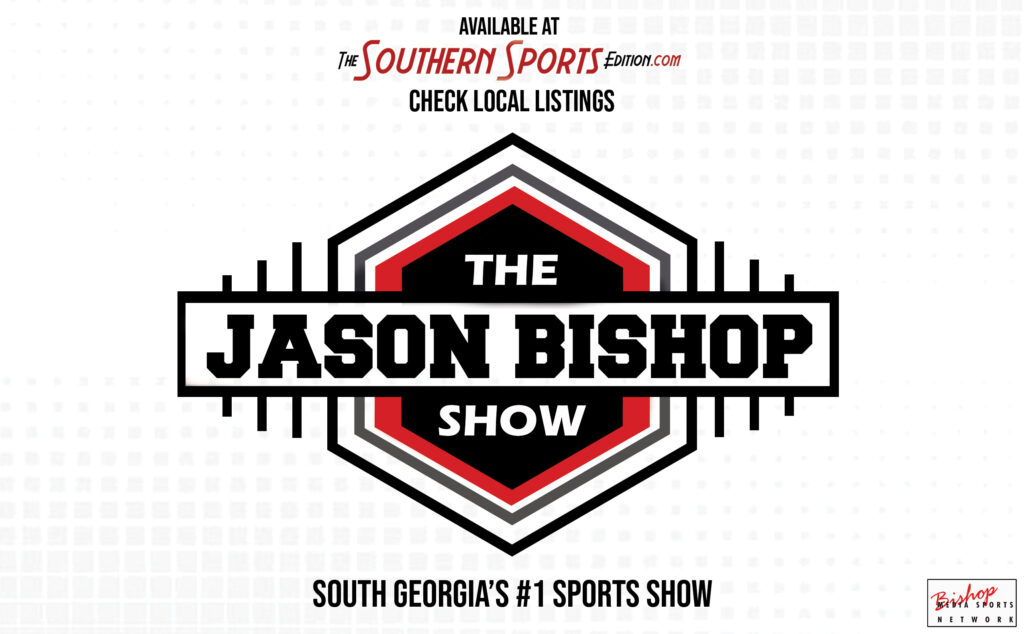Robert Craft
Kirby Hates Florida
 By: Robert Craft
By: Robert Craft
TheSouthernSportsEdition.com news services
Kirby Smart Hates Florida. He hates them with the fire of a thousand suns.
He gives the media plenty of coach speak about how Florida is another game, and all league games are important. He tells the cameras that he and his staff must prepare the same every week.
He says that great talent exists across college football, and anyone can beat you any day of the week. Despite all of that talk, Kirby Smart lives to beat Florida.
He has made beating the Gators a priority and celebrated the last two victories over Florida with a level of expression that ‘Stern Smart’ rarely shows.
At this point, it’s well known that Smart was a safety at Georgia from 1995-1998. He recorded 13 interceptions for the Bulldogs and was an All-SEC selection his Senior year. Smart’s time wearing silver britches also coincided with some of the worst beatings in the history of the Florida-Georgia rivalry.
Smart’s teams lost to the Gators 52-17 in 1995, 47-7 in 1996 and 38-7 in 1998. Kirby and the Dawgs did get to taste victory in 1997, when they pulled a 37-17 upset over the Gators. It would be Georgia’s only victory out of 14 meetings against the Gators.
Steve Spurrier hated Georgia for beating him in his senior season of 1966 when the Dawgs upset the Gators 27-10. The loss cost UF their first SEC Championship, and Spurrier never forgot. That loss kept him from becoming a champion. Needless to say, Spurrier made beating Georgia a priority throughout his coaching career.
For years UGA had a lovely habit of beating Florida anytime the Gators had a good season, and that ownership created the monster that ended Georgia’s dominance in the rivalry.
Let’s go back to the infamous 1995 game against the Gators. Georgia and Florida played in Sanford Stadium due to the old Gator Bowl being renovated, and prior to the game Steve Spurrier found out that no opponent had ever scored 50 points between the hedges.
With the game out of reach late in the fourth quarter, and the Gators leading 45-17, Spurrier continued to call passing plays for backup quarterback Eric Kresser.
The Gators ran a flea-flicker, at one point on their final drive and moved the ball down to Georgia’s 10-yard line instead of running out the clock. With 1:10 remaining Kresser threw a touchdown on a slant to Travis McGriff.
I found something fascinating watching the end of that game on YouTube. Do you know who McGriff jogged past right after he caught that final touchdown?
True freshman safety, Kirby Smart.
The Gators ran the score up to embarrass the Dawgs, and that’s when Spurrier passed the flaming torch of revenge to Smart.
A little over 24 years ago, Steve Spurrier created the man who would bring Spurrier-style vitriol and hatred to the Bulldogs’ side of the rivalry. That man is Kirby Smart.
80 Million Dollar Mistake?
 By: Robert Craft
By: Robert Craft
TheSouthernSportsEdition.com news services
None of the given explanations made sense. Nothing would have.
Mario Cristobal blew it.
Miami lost a game they shouldn’t have, in stunningly idiotic fashion.
If quarterback Tyler Van Dyke was ordered to take a knee on a third-and-10 with a running clock at under 40 seconds, the Hurricanes would be 5-0; talking about how they escaped with an ugly 20-17 win over Georgia Tech.
Instead, the sports world is scratching their heads wondering why he handed the ball off to Don Chaney Jr.
The Yellow Jackets ran out of timeouts, and that led to the fumble that set up the Yellow Jackets’ miracle comeback.
Chaney was closing in on his first 100-yard rushing game of his career. He was sitting on 99 yards when he carried it for the final time.
When asked directly about why he called the run play, Cristobal denied that the 100yd milestone was the reason. At the end of the game, Miami’s official stats later reflected that Chaney finished with 106 yards, but in real-time Miami’s official stats listed him at 99 yds before his final carry.
Why did Miami not take a knee and take the W?
Hurricane fans, how does this unimaginable and embarrassing loss take place?
It’s a mistake you’d think every coach would avoid. Cristobal, though, has fallen victim to running an unnecessary play in a clock-killing situation twice now. It happened to his team at Oregon in 2018.
The Ducks led Stanford 31-28 late, and quarterback Justin Herbert could have knelt to run the clock down to 16 or fewer seconds and set up a punt near midfield.
Instead, Oregon running back CJ Verdell ran it on second-and-2 and fumbled. The Cardinal took over with 51 seconds remaining, forced overtime and went on to beat the Ducks 38-31.
Cristobal’s explanation about Saturday’s clock management strategy on the final drive didn’t make much sense.
Why would any coach in their right mind run it on third-and-10 with 33 seconds left in the game after Georgia Tech had used its final timeout two plays earlier?
What were the final 26 seconds like for the guy in charge on the other sideline? Well, Georgia Tech coach Brent Key was stunned Miami didn’t take a knee either.
Surprise turned to elation when his team pounced on its opportunity, as Haynes King connected with Christian Leary on the game-winning 44-yard touchdown pass with only two seconds left.
Miami has not won an ACC home game under Cristobal. They’re 0-5 in league play at Hard Rock Stadium since December 2021. Cristobal is looking a lot like the 10-year 80 dollar mistake.
He blew a huge opportunity Saturday to prove Miami was past its bye-week blues and capable of handling a three-touchdown underdog.
The Hurricanes may redeem themselves by beating a Tar Heels team they’ve lost four consecutive games to, followed by a Clemson squad that has beaten them by a combined score of 178-30 in their last four meetings.
It’s not impossible. Nothing in this article says this Miami team is untalented.
Dumber things have happened. Coaches have an infinite potential of stupidity.
I’m not sure we’ll see anything dumber than what we saw this Saturday for quite some time. Where were you while Hurricane history was taking place?
Unpaid Workers
 By: Robert Craft
By: Robert Craft
TheSouthernSportsEdition.com news services
Much of the discourse at Wednesday’s legislative hearing on NIL centered around pay-for-play and NIL collectives.
With two sitting athletic directors as witnesses and a former Heisman Trophy winner as a third, the narrative of what the NCAA wants to see fixed in college sports was clear.
More guidelines. A different framework. Ability to crack down on inducements.
The nearly two-hour hearing before the House Committee on Small Business on Wednesday won’t inch Congress any closer to delivering the NCAA its long-sought federal bill.
Remember this hearing for another reason: It highlighted what lawmakers of the NCAA’s efforts to lobby Congress. The NCAA is confronting the brink of a revolutionary transformation- ushered in by the NIL era two years ago.
The NCAA is a powerless organization with no ability to build consensus among power conferences. It feels each team has been busy all summer poaching each other’s schools to construct super conferences, funded by billions of TV dollars, while side stepping what’s permitted to line the pockets of athletes and coaches.
Here’s the reality: The winds of change are fiercely blowing in one direction: toward a long-overdue revenue-sharing model. The NCAA has exerted all of its’ efforts toward leaning on Congress to save it.
Its wish list includes a preemption of state NIL laws, at least partial antitrust protection, and a formal designation that athletes are not employees.
Congress wants clear, concise messaging on what solutions college stakeholders seek. Right now, there is no clear messaging. As a result, Congress isn’t eager to solve the NCAA’s problems.
Here’s why no clear messaging to congress is a critical issue in the NIL space. Evolving NCAA guidance still maintains the need for established distance between schools and collectives.
Most Power 5 schools are ignoring that guidance. Lack of regulation matters because 95% of collective dollars go to male athletes.
On another note, discussion centered on the need for more transparency, uniformity on NIL contracts, and a collective agent registry.
The NCAA’s NIL subcommittee this summer was green-lighted to develop those elements, along with an NIL database. Votes on those policy changes will occur next month and in January.
Overall, for all their efforts lobbying Congress, which has intensified in recent months, the NCAA’s ball hasn’t moved. It’s mired on the wrong side of the field, facing fourth-and-long and needing a Hail Mary with no quarterback.
With the NCAA ceding all opportunities to get in front of developments, the action will occur in the courtrooms, continuing as soon as tomorrow.
Like it or not, a new model is coming. The NCAA chooses to play the role of bystander, futilely pleading for a Congressional helping hand.
Fans, keep your eyes on “ Johnson vs. NCAA and House vs. NCAA, these two are working their way through the courts.
Also, the National Labor Relations Board’s Los Angeles office has filed its unfair labor practice complaint against USC, the Pac-12 Conference and the NCAA (a hearing is scheduled for Nov. 7).
These machinations are viewed as a slow march toward student-athletes being designated as employees. That probable scenario will dramatically reshape college athletics.
QB-0
 By: Robert Craft
By: Robert Craft
TheSouthernSportsEdition.com news services
There were moments during the Alabama-USF game when Nick Saban was in pure anguish. The sideline faces of Saban have always been a trip, even when his team is playing brilliantly but this was different.
These faces, or blank stares, were coming from a man who seemed numb. It felt like he was nonverbally asking the question: “How did The University of Alabama get here?” How?
How did Alabama — the most consecutively talented team in modern college football — get to a place where they don’t have a quarterback?
That’s a complicated question to answer. It’s not like Alabama didn’t create options through recruiting and the transfer portal. The Tide came into the season with five quarterbacks on the roster, each ranked among the top 160 as a recruit.
Among them Jalen Milroe, Tyler Buchner, Ty Simpson, Eli Holstein and Dylan Lonergan, someone would figure it out, right?
They are all from different places, having varying experience levels and with different styles of play. Everybody continued to just assume the great Saban would find one of them to lead this ultra-talented team back to the College Football Playoff. What evidence in the past has proven this assumption wrong?
It turns out, in the 2023 season- Alabama has a problem not even Saban can solve, even if he’s the greatest coach in college football history.
Sometimes coaches, even the great ones, hit a lull and that can lead to some uncomfortable moments on gameday. This isn’t to say Saban lost his touch or no longer knows the quarterback recruitment landscape. This could be a result of constant assistant turnover on his staff.
Whatever the root may be, the issue has become increasingly clear: there’s a disconnect between the players they are recruiting and the output delivered on the field. This seems to be an evaluation and developmental issue, which could mean bad years ahead for the longtime greats.
What production has Alabama put on the field recently. I’m not sure anyone could watch that and say something isn’t wrong. And it’s not a numbers issue. The Tide successfully signed a QB in a recruitment class and had players transfer in.
These aren’t the normal transition pains a program experiences when it transitions from a Heisman Trophy-winning quarterback to someone new. This is what it looks like to go from elite to bad.
We’re talking about the same coach and program that put a true freshman into the national championship game at halftime and let him fling it. It didn’t take Tua Tagovailoa long to show everyone he was a star.
What’s truly bizarre is why Milroe didn’t play at all in the USF game. Through all the agony coming through on the television, you’d think the Crimson Tide would have turned to the most experienced quarterback on the roster who surely could have made plays with his legs to win the game. Instead, it seemed like a prolonged experiment from Saban to see whether someone anyone could quarterback this team.
Talent, legendary coaching, incredible fans, intimidating stadium, the lore of being one of the best programs in college football history…None of it matters if you don’t have someone special taking the snaps.
Look at the entire SEC — the conference seems down because the quarterback play has been down. Look at all of the non conference games the SEC has lost this season.
In almost every single one, the team that beat the SEC squad had an advantage at quarterback.
Even the greatest coach of all time can’t solve the issue of not having a top-level quarterback, whether he is to blame or not.
Power Surge
 By: Robert Craft
By: Robert Craft
TheSouthernSportsEdition.com news services
I don’t know the journey the 2023 Braves will lead, but I now know the magnitude of their journey to this present moment.
They haven’t merely wrapped up the National League East. Their lineup is doing things baseball fans haven’t seen done in 50 years, 90 years, 100 years … or ever, for that matter, and that’s only now dawning on them.
There’s something funny about making history, you see. You don’t always recognize it when you’re in the middle of it, living and watching it, day in and day out.
There’s no perfect stat. There’s no perfect metric that reveals, unequivocally, the identity of the The Greatest Offense of All Time. So, if you’re even in the argument, alongside those ’27 Yankees, there’s no need to quibble about where to place the decimal points. We’re witnessing greatness, period.
Here’s an incredible difference between these Braves and those Yankees. Babe Ruth and Lou Gehrig were twice as good at creating runs as the average hitter of that era, but they were part of a top-heavy lineup that didn’t have the depth of this Braves lineup, believe it or not the Braves are deeper and a higher utility team.
It doesn’t get much more old-school than home runs and stolen bases. And the triple digits in those categories are a reminder that the Braves can beat you one way on night one and a whole different way on night 2.
That 2019 Twins team that set the home run record the Braves are chasing, for most homers in a season (307). That team stole 28 bases all season. Ronald Acuna almost had that many himself by Memorial Day.
Even if they take their foot off the gas in the next few days, the Braves are almost a lock to lead the majors in homers by 50. No team has even done that in 55 years.
Only two teams in history that stole 100 bases even reached 250 homers the same season: the 2019 Brewers (250) and last year’s Yankees (254).
Hard to argue that this team isn’t special! The only two previous teams in history to bop 300 homers, the 2019 Twins and 2019 Yankees. They stole 83 bases combined. Acuña is on pace to steal 73 this year all by himself.
The Braves could have nine players with at least 20 homers! No team has ever done that.
The Braves could also have five players with at least 30 homers! Only the 2019 Twins have done that. And they just became the first team ever to have four men hit 35 or more.
They could lead the sport in slugging by 40 points! (They were at 43 through Sunday.) The only teams since 1900 to do that are the ’27 Yankees and 1953 Boys of Summer Dodgers.
I could spit out many more magic numbers for these Braves. But I’ve made my point. I never saw Ruth and Gehrig in 1927, but I’m watching Acuña and Olson here in 2023.
Now, there’s one more thing that needs to happen, one more thing they need to accomplish to make this season truly special, and historic.
The Braves just have to finish it. If October goes like the first six months of this season, they’ll be swirling around all these numbers for the rest of their lives.
If the Braves fail to win The World Series, they are just numbers that will be semi-forgotten.
House Of Horrors
 By: Robert Craft
By: Robert Craft
TheSouthernSportsEdition.com news services
Neither team is in the top 10. In fact, only one of them is ranked. There are no Heisman favorites playing. But make no mistake, Saturday’s Florida Gators-Tennessee Vols game at the Swamp is big. Always expect a sellout crowd.
Tennessee looks to win back-to-back games over Florida in the rivalry for the first time since 2003-2004 and to win in The Swamp for the first time since 2003.
The Vols are coming off an exciting 38-33 win over the Gators at Neyland Stadium a season ago, a victory that sparked the 11-win campaign.
Josh Heupel’s bunch looked out of sorts against Austin Peay last week, thus getting back on track and having proper communication is key as this matchup will be the first true road game of the season for the Big Orange.
It’s a massive game for both parties involved. The contest will be the ‘tempo setter’ for the Vols and the first challenge ahead of a grueling SEC schedule.
For the Gators, this is a critical rivalry game with Billy Napier, this is the biggest game in his coaching career. Both squads are trying to find themselves early in the season, but the game slows down for no one.
Florida is eager to make a statement under Napier. They want to show that they’re going to take a step forward in Napier’s second season. Beating Tennessee, especially after losing to the Vols last season, would certainly send a message that Florida is moving in the right direction under Napier.
For Tennessee, the Florida game is the first real obstacle in their quest for a SEC East division title. With Georgia looking like a good bet to run the table until their late November matchup with the Vols, Tennessee knows that a loss to Florida on Saturday in the Swamp will make winning an SEC East title significantly tougher, if not impossible.
Through two games, this typically high flying Tennessee offense—or more specifically the passing game element of that offense—hasn’t been racking up the explosive plays like fans are accustomed to seeing.
Heupel understands that there’s frustration about Tennessee’s performance on Saturday in a game that most expected would be well in hand by halftime.
The Vols are running the ball great at the moment, averaging 6.1 yards per carry on the season. The aforementioned SEC-worst 6.67 yards per passing attempt is holding the offense back.
Tennessee is converting just 32% on third down, which ranks 13th in the SEC. That’s also a concern but the Vols haven’t exactly faced a murderer’s row of defenses in the first two weeks.
Florida has potential to surprise people this season but could struggle to reach bowl eligibility.
I side more so with the latter. I am not a believer in Graham Mertz and don’t see Florida having a good pass rush.
The receiver’s youth won’t help Mertz, and shaky offensive line play will prevent Florida’s run game from reaching its potential. With that, the Swamp will impact The Vols offense. That should go without saying.
Gainesville is a house of horrors for Tennessee, no question about it. And if there is one must-win game for the Gators in 2023, it’s Tennessee.
With the game being in week three, Florida needs to set the tone for the rest of their season.
Florida 27 Tennessee 24
Loud War Chant
 By: Robert Craft
By: Robert Craft
TheSouthernSportsEdition.com news services
On the heels of the Seminoles’ 45-24 drubbing of No. 5 LSU on Sunday night, it’s time for my 3-2-1, where I offer up three observations and one prediction about Florida State football.
Three things I learned.
1 — This team’s chemistry might be even stronger than 2022:
You didn’t have to be a scout to like Florida State’s roster entering the 2023 season.
The Seminoles were bringing back the vast majority of their production from a 10-3 team, and they brought in a slew of talented, experienced transfers to add to the mix.
At wide receiver, tight end, cornerback and on the O and D lines, Florida State landed several of the very best players in the transfer portal. You saw many of them shine Sunday night against LSU — everyone from Keon Coleman, Jaheim Bell and Jeremiah Byers to Braden Fiske, Fentrell Cypress and Gilber Edmond.
Physically, I think most of us expected the Seminoles to be a better football team this fall than last.
While it was only one game, and there undoubtedly will be more difficult moments down the road, there were a ton of great signs of the togetherness and commitment these players have for each other.
From the defense delivering two huge fourth-down stops in the first half, to the offense sticking together until things began to click late in the second quarter.
Jordan Travis displayed remarkable leadership after a couple of costly early mistakes and drops.
We don’t know if it will always be like this. Heck, emotions and circumstances derail college football teams all the time. I thought it was fair to wonder how this team might be affected by lengthy expectations with a changing roster and the complications that come with money.
To the contrary, I think this team might have even more positive energy and leadership than the program did in 2022. And that is saying something.
2 – Second-quarter drive spoke volumes:
As poorly as Florida State’s offense was performing for most of the first two quarters Sunday night, there was a real chance FSU ended in too big of a hole at halftime to climb out from.
They were trailing 14-7 midway through the second quarter. The offense had just finished their last four drives with three punts and an interception. There was another near-interception in there that could have been disastrous — deep in FSU territory.
When the Seminoles got possession at their own 25-yard line with 6:02 remaining in the first half, I felt like they were teetering on disaster.
If the offense didn’t find the end zone on that drive, Florida State likely would have been trailing by two scores at halftime, and LSU would have had a ton of momentum, a world of confidence, and a winning chance.
The second half the Seminoles took control of the game. But those early fourth-down stops — and that big answer by Travis in the second quarter — are what made their win possible.
3 – Player development was on full display:
The transfers will get most of the attention, and rightfully so.
Former Michigan State star Keon Coleman caught three touchdown passes. Former South Carolina star Jaheim Bell scored two touchdowns of his own. Transfers played well in their FSU debut.
But several “program players” — guys who have been at FSU for their entire careers — came through at important moments and showed just how far they have come during their time in Tallahassee. Here are a few who stood out Sunday:
Linebacker DJ Lundy came through with a huge fourth-down sack of LSU quarterback Jayden Daniels to thwart one scoring opportunity, and he was in on another tackle for loss.
Lundy now looks like a completely different player than when he was forced into early action back in 2020 and 2021.
This defense will give Florida State every opportunity to achieve any goal this season, and Jordan Travis & the offense is explosive. I am calling it now FSU 13-0.
Fans, time to buy your playoff tickets.
Gator Kickoff Preview
 By: Robert Craft
By: Robert Craft
TheSouthernSportsEdition.com news services
The Florida Gators open their 2023 season Thursday at Utah, the second matchup of their home-and-home series with the back-to-back Pac 12 champions.
UF upset the No.7 Utes last year in The Swamp, 29-26, as Billy Napier became the school’s first coach to defeat a ranked team in his debut.
Here are three key matchups in this year’s game between the Utah offense and Florida’s defense:
New UF defensive coordinator Austin Armstrong is going to bring the house against Cam Rising. One of Armstrong’s trademarks as the Southern Miss DC was getting after the quarterback.
Rising tore his ACL on Jan. 1 in the team’s Rose Bowl loss to Penn State and he didn’t participate in 11-on-11 drills during fall camp. He’s still expected to play and listed him as the starter on its Week 1 depth chart.
The Utes allowed just 15.0 sacks last season, which ranked No. 20 nationally. They return three offensive line starters and a fourth player who made two starts in 2022.
Rising also threw for 216 yards at Florida last season, with tight end Brent Kuithe accounting for almost half of them.
Kuithe suffered a torn ACL last season on Sept. 24 against Arizona State. He was limited in fall camp but should be greenlit for the opener.
The Gators must do a better job defending Kuithe on Thursday, luckily they have a few more coverage options to throw at him this time around.
In addition to Rising, Florida was also torched by Tavion Thomas on the ground. The former Utah running back rushed 115 yards and a touchdown on 23 carries in The Swamp. Not a good look.
It must have been foreshadowing, because The Utes finished with the No. 11 rushing offense in the FBS at 217.6 yards per game, while Florida’s rushing defense ranked 100th nationally.
Utah returns two backs in sophomore Ja ‘Quinden Jackson and junior Micah Bernard, both of whom eclipsed 500 yards rushing last season.
Bernard had 106 carries for 533 yards and four touchdowns, while Jackson rushed 78 times for 531 yards and nine TDs. Jackson has been named Utah’s starting running back in this mean rotation.
The Gators lost four full-time starters from last year’s offensive line and the status of redshirt junior center Kingsley Eguakun is in question.
They may return with all new guys if Eguakun isn’t cleared. Regardless of who starts , it will be key for the Gator Offensive Line to handle the road environment well and assist redshirt junior quarterback Graham Mertz in getting settled.
The Gators boast one of the best tailback tandems, junior Montrell Johnson Jr and sophomore Trevor Etienne aka TNT.
They will be featured much more in this year’s Utah matchup. It’s going to take a heavy dose of Etienne and Johnson for Florida to win this game.
That will be easier said than done against the Utes and their No. 18 national rank in rushing defense. They allowed only 111.23 yards per game.
Utah ranked No. 1 in the Pac 12 and tied for eighth nationally in sacks last season, registering 41.0 total sacks to average 2.39 per game.
The Gators didn’t give up any sacks last year’s game. If Mertz can handle Utah’s pressures and the O-line protects him, the Gators have a great shot. But this year I don’t think a shot will be enough to take this one home.
Utah 31 Florida 20
Gator Bait
 By: Robert Craft
By: Robert Craft
TheSouthernSportsEdition.com news services
Here are my predictions for Florida’s W-L record in 2023, with the % chances for a Gator win in parentheses — according to ESPN matchup predictor..
Aug. 31, at Utah (29.7% chance):
A lot of this depends on Cam Rising. Even if he’s healthy, what will he look like in his first game back from surgery? The Florida defense will have to keep the Gators in the game, and I think they will. But it still looks like a loss. (Utah)
Sept. 9, McNeese State (99% chance):
The Gators get a cupcake game for their home opener after having to wait five weeks for one in 2022. (Florida)
Sept. 16, Tennessee (51.7% chance)
This week-three matchup is the one that could either generate significant momentum or place Gator Nation down in the dumps. The last time the Vols won in The Swamp, most of the players on the field hadn’t been born yet. I’m not buying the Joe Milton hype right now. (Florida)
Sept. 23, Charlotte (96.3% chance)
The second cupcake game of the season. It gets real after this. (Florida)
Sept. 30, at Kentucky (48.4% chance)
The hope for the Gators is that the offensive line won’t commit eight false starts again in Lexington, and Graham Mertz will take care of the ball better than A.R. did last year.
At this point in the season, younger players on the roster will be stepping up and making an impact. (Florida)
Oct. 7, Vanderbilt (90.4% chance)
This won’t be a repeat of 2022. The Gators should never lose to Vanderbilt on the football field, and they’ll correct that in 2023. (Florida)
Oct. 14, at South Carolina (58.9% chance)
The Gamecocks bring back Spencer Rattler, which has them getting more hype than they deserve this offseason. If the Gators want to record a statement road victory against South Carolina, they will need to take control of the football and make the most of their possessions. That starts at the quarterback position with Graham Mertz. (South Carolina)
Oct. 28, Georgia (13.8% chance)
For me, Georgia is a much better team. Coming off back-to-back national championships, Georgia’s defense is going to be scary. Florida doesn’t have the roster to compete with the Bulldogs. (Georgia)
Nov. 4, Arkansas (66.2% chance)
Arkansas is on the rise under Sam Pittman and they continue to upgrade their roster.
This game could go either way and should be a close one til the end, but playing at the Swamp could be the difference maker. The Swamp will be packed with recruits wanting to see the black uniforms, and the Gators cannot bring them out and lose. (Florida)
Nov. 11, at LSU (18.5% chance)
The Gators kept pace in this rivalry game, but Jayden Daniels and the Tigers will be too much to handle in Death Valley. (LSU)
Nov. 18, at Missouri (58.1% chance)
I will say this … I have seen Florida lose this game. Late in the season, likely a noon (11 am local) kickoff. It will be early, cold, and mostly empty in the other Columbia. Sandwiched between LSU and FSU, this has trap written all over it. (Florida)
Nov. 25, FSU (50.3% chance)
Florida State comes into The Swamp as a College Football Playoff contender. This year’s home matchup against FSU is a tossup due to the emotion of the game and Florida being at home.
The Seminoles are the more talented program right now, but that’s not always the deciding factor in a rivalry match. (FSU)
Frankly, the schedule is a bear. Mertz isn’t a great quarterback but the offense isn’t the real problem. It’s the Defense!
If Florida’s Defense doesn’t improve this season, the Gators will struggle to win 6 games and they won’t have a season to be proud of.
UCF Knights 2023 Preview
 By: Robert Craft
By: Robert Craft
TheSouthernSportsEdition.com news services
“When you look at your schedule, there’s no off weeks,” UCF head coach Gus Malzahn said. “You’ve got to bring your A-game every week. That’s really what stands out to me coming in as a new kid on the block.”
Without a doubt, 2023 boasts the toughest schedule in UCF football’s history.
It’s exactly what the Knights want: the chance to play before sold-out crowds on tradition-rich Big 12 campuses.
With the five Big 12 road games and one at Boise State in non-conference play, it’s still a more manageable schedule than any other BIG 12 team.
Let me be clear- it’s not all going to be easy. Those road dates at Kansas State, Oklahoma, and Texas Tech will keep UCF from cranking out a massive debut season.
Do the Knights have the skill level, depth, and toughness to compete in their new conference?
Head Coach Gus Malzahn has been preparing for UCF’s first season in the Power 5 for two years, with the goal of building a roster that’s able to match up with the Big 12.
Malzahn and his staff dove into the transfer portal, adding 18 new transfers to the 2023 roster. A handful of hot-handed new players come with Power 5 experience and clout.
John Rhys Plumlee (JRP) returns for year two at UCF as one of Malzahn’s most trusted leaders, entrenched as the starting quarterback.
JRP returns with a wealth of talent around him, from receivers Javon Baker, Kobe Hudson and Trent Whittemore to tight end Alec Holler and running backs RJ Harvey, Demarkcus Bowman, and Johnny Richardson.
There’s a new playcaller at UCF. Malzahn brought in offensive coordinator Darin Hinshaw this offseason.
Before Malzahn arrived at UCF, the Knights boasted one of the most explosive offenses in the country. The scoring average dropped from 40+ points per game in 2020 to around 32 per game in 2021 and 2022. Big 12 dogfights will happen this season. UCF must keep up.
The Knights defense is okay at best. They need to be a more disruptive force to win games this year.
The run defense got ripped up late last season, the pass defense had issues during the middle of the season. There are enough good veterans back to be better in 2023. Against real competitors, will UCF only be able to perform on one side of the ball?
For the fans: There will be an upset here and there, but there also isn’t a sure win outside of Kent State and Villanova. Are you worried?
Don’t underestimate anything this team and program can do, but figure on at least two losses between the road trips to Boise State, Oklahoma, and Kansas State, and at best the away games against Cincinnati, Kansas, and Texas Tech are 50/50.
With a manageable schedule, will UCF manage a successful season?
My concern is for quarterback health. Rhys Plumlee doesn’t shy away from contact and is regularly on the move behind an offensive line that may be worse than last year’s. Taking hits piles up, and he’s already missed games in his career. If Rhys Plumlee misses games in 2023, UCF is in serious trouble.
UCF could win 8 or 9 game with a healthy Plumlee but if he’s injured or playing hurt 6 or 7 games is the ceiling.
